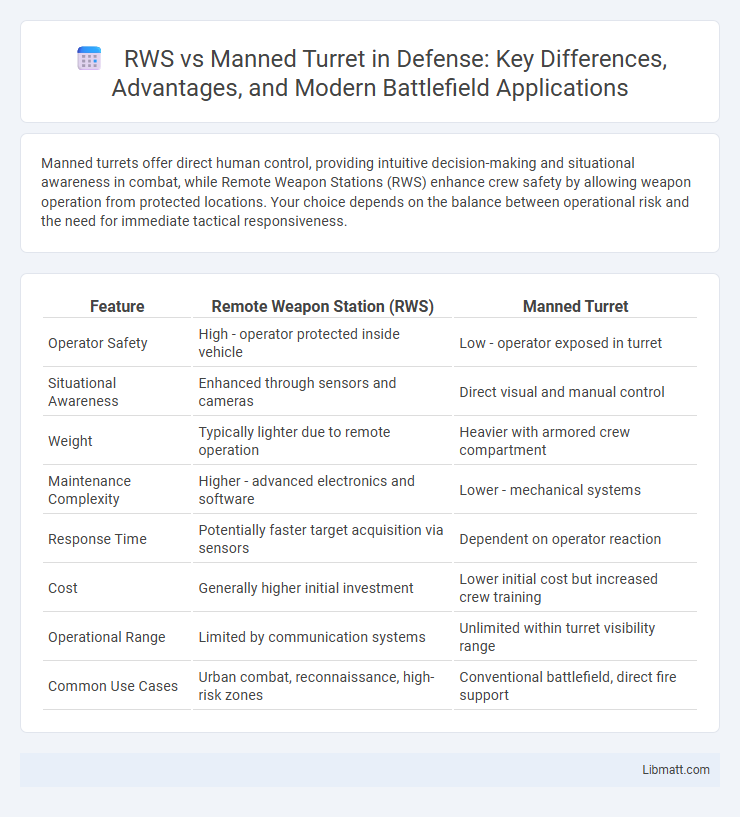Manned turrets offer direct human control, providing intuitive decision-making and situational awareness in combat, while Remote Weapon Stations (RWS) enhance crew safety by allowing weapon operation from protected locations. Your choice depends on the balance between operational risk and the need for immediate tactical responsiveness.
Table of Comparison
| Feature | Remote Weapon Station (RWS) | Manned Turret |
|---|---|---|
| Operator Safety | High - operator protected inside vehicle | Low - operator exposed in turret |
| Situational Awareness | Enhanced through sensors and cameras | Direct visual and manual control |
| Weight | Typically lighter due to remote operation | Heavier with armored crew compartment |
| Maintenance Complexity | Higher - advanced electronics and software | Lower - mechanical systems |
| Response Time | Potentially faster target acquisition via sensors | Dependent on operator reaction |
| Cost | Generally higher initial investment | Lower initial cost but increased crew training |
| Operational Range | Limited by communication systems | Unlimited within turret visibility range |
| Common Use Cases | Urban combat, reconnaissance, high-risk zones | Conventional battlefield, direct fire support |
Introduction to RWS and Manned Turret Systems
Remote Weapon Systems (RWS) enable operators to control weaponry from a protected location, enhancing safety and situational awareness through integrated sensors and automated targeting. Manned turret systems require personnel to be physically present within the turret, providing direct manual control but exposing crew members to higher risks during combat. Your choice between RWS and manned turrets depends on mission requirements for protection, control precision, and operational flexibility.
Key Differences Between RWS and Manned Turrets
Remote Weapon Systems (RWS) enable operators to control weapons from a protected location, enhancing crew safety by reducing exposure to direct enemy fire. Manned turrets require personnel to be physically present in the turret, offering immediate situational awareness but increasing vulnerability. Your choice depends on the mission's emphasis on crew protection, situational awareness, and operational flexibility.
Historical Development and Evolution
Remote Weapon Systems (RWS) have evolved from early missile-guided platforms to highly sophisticated, sensor-integrated weapon stations, enhancing precision and crew safety compared to traditional manned turrets. Manned turrets have a long history dating back to World War I, with continuous improvements focusing on armor protection and manual targeting; however, they expose operators to battlefield hazards. You can leverage RWS advancements that integrate automated threat detection and remote control, marking a significant shift from the direct, manual engagement methods of manned turrets.
Advantages of Remote Weapon Stations (RWS)
Remote Weapon Stations (RWS) offer enhanced crew protection by allowing weapon operation from within armored vehicles, reducing exposure to enemy fire. These systems provide superior targeting accuracy through advanced sensors, stabilization technology, and integration with battlefield management systems. RWS increase operational flexibility and reduce crew fatigue by enabling remote control of multiple weapon types, improving overall combat effectiveness.
Benefits and Limitations of Manned Turrets
Manned turrets offer enhanced situational awareness and immediate threat response capabilities due to direct operator control and onboard observation systems. However, they expose personnel to higher risks in combat environments, increase vehicle weight, and limit mobility compared to Remote Weapon Systems (RWS). The physical presence of crew members in manned turrets restricts design flexibility and complicates integration of advanced technologies.
Operational Safety and Crew Survivability
Remote Weapon Systems (RWS) significantly enhance operational safety by allowing weapons to be operated from within armored vehicles, reducing crew exposure to hostile fire and environmental hazards. Manned turrets expose crews directly to battlefield threats, increasing vulnerability and risk during combat operations. Your choice of RWS improves crew survivability by integrating advanced targeting and stabilization technologies, minimizing human error and enhancing situational awareness.
Technological Advancements in Both Systems
Remote Weapon Stations (RWS) have significantly advanced with integrated AI targeting systems, enhanced stabilization, and real-time data link capabilities, offering superior precision and situational awareness compared to traditional manned turrets. Manned turrets have also evolved, incorporating improved ergonomic designs, modular weapon mounts, and advanced sensor packages that enhance operator control and survivability on the battlefield. Your choice between these systems should consider the technological enhancements in automation and human-machine interface that influence operational effectiveness and mission adaptability.
Cost and Maintenance Considerations
Remote Weapon Systems (RWS) reduce long-term operational costs by minimizing crew requirements and exposure to battlefield risks, which decreases personnel training and casualty expenses. In contrast, manned turrets often entail higher maintenance costs due to complex mechanical parts and the need for frequent servicing of life-support systems. While RWS benefit from modular designs allowing easier upgrades and repairs, manned turrets demand more intensive upkeep, increasing overall lifecycle expenditures.
Applications and Use Cases in Modern Warfare
Remote Weapon Stations (RWS) are increasingly deployed on modern military vehicles for precise targeting and enhanced crew protection in urban and asymmetric warfare environments. Manned turrets remain favored in scenarios requiring direct human control and rapid decision-making, such as complex engagement zones and dynamic battlefields. Both systems complement each other by providing versatile firepower options tailored to distinct operational demands in contemporary combat.
Future Trends: RWS vs Manned Turret
Remote Weapon Stations (RWS) are increasingly favored in future battlefield scenarios due to enhanced survivability, reduced crew risk, and integration with advanced sensors and AI for autonomous targeting. Manned turrets, while offering direct human control and situational awareness, face limitations in crew safety and ergonomic challenges under high-threat environments. Emerging trends indicate a gradual shift towards hybrid systems combining RWS flexibility with limited manned control for optimized operational effectiveness.
RWS vs manned turret Infographic

 libmatt.com
libmatt.com